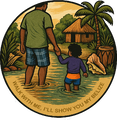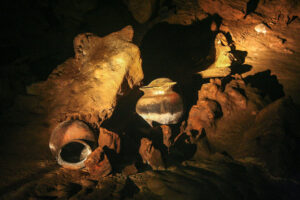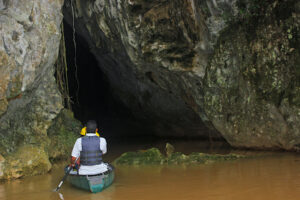Cenotes in Belize: Hidden Pools, Ancient Portals, and the Truth Beneath the Surface
When travelers ask, “Are there cenotes in Belize?” the answer is:
Yes — Belize has real cenotes. But they’re not advertised like Mexico’s. They’re hidden, sacred, and waiting to be understood.
Some you can visit. Others are buried in jungle silence, known only to Maya elders, archaeologists, or the land itself.
Let me show you what most travelers — and even many Belizeans — don’t know.
🗺️ Cenotes in Belize You Can Visit
🌿 1. St. Herman’s Blue Hole
📍 Hummingbird Highway
💧 Swimmable freshwater jungle cenote
🛣️ Access: 2-minute walk from the visitor center at St. Herman’s Blue Hole National Park. $5 BZD entry. Facilities and changing rooms available.
🔗 [Tour St. Herman’s + Cave Combo with Me]
🗣️ The Blue Hole is a favorite stop for many Belizeans and my own family. Whether we’re driving from the coast to San Ignacio, or from the hills down to Hopkins or Placencia, it’s our cool-down break. I’ve been coming here since childhood — the park has come a long way with many upgrades since then.
🌿 2. Toledo Jungle Cenote (Local Access)
📍 Toledo District
🌀 Deep limestone collapse in rainforest
🛣️ Access: Remote — you’ll need a guide with connections to local communities. Some trails unmarked.
🔗 [Request a Custom Jungle Tour to Toledo]
💬 This cenote is known to a few elders and naturalists. It’s not on the maps — but the land remembers.
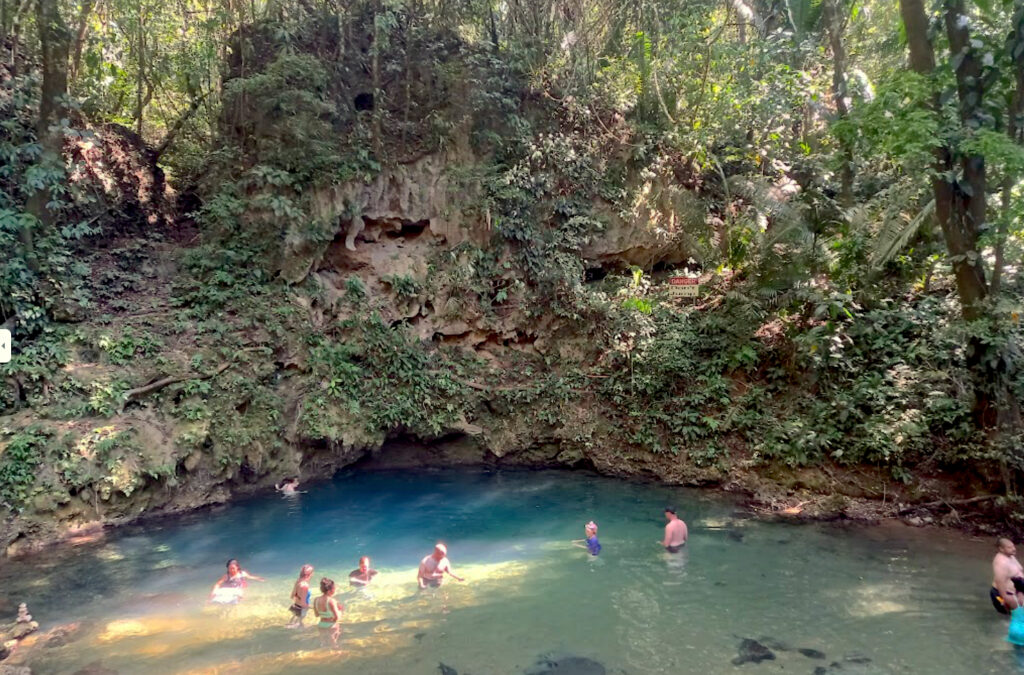
Cenote vs Cave: What's the Difference?
Belize is more famous for its cave systems than its cenotes — but the two are deeply connected.
Cenotes are typically formed by collapsed cave ceilings that expose groundwater. Caves may remain enclosed or connected to river systems deeper underground. In fact, many of Belize’s caves — like Actun Tunichil Muknal or Barton Creek — began as cenote-like sinkholes that opened into much larger passageways.
So, when you hear “cave” in Belize, there’s a good chance it once functioned like a cenote — or still does during the rainy season, when water levels rise and collapse points flood.
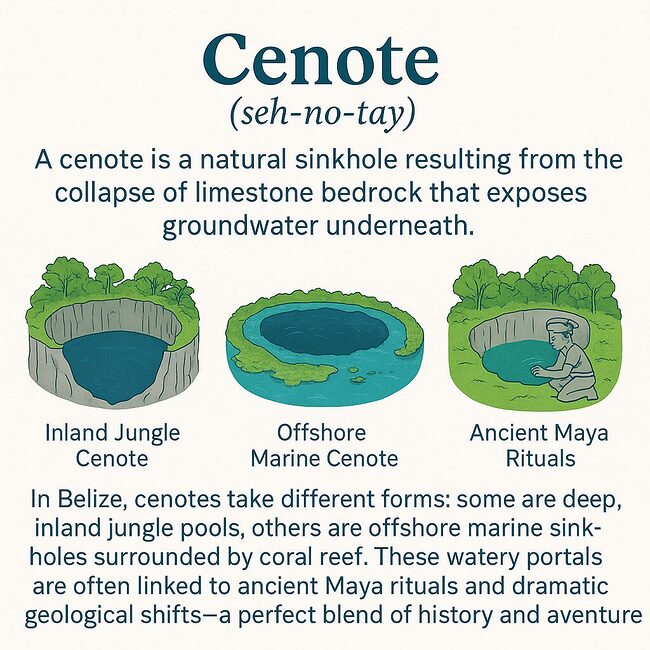
🌊 Cenote-Like Caves and Pools in Belize
(Not officially called cenotes, but offer the same water, geology, and spiritual feeling)
💧 3. Blue Creek Cave
📍 Southern Toledo
🌿 Cave river meets jungle pool
🛣️ Access: Small hike from Blue Creek Village. Footpath crosses shallow water. Local guide recommended.
🔗 [Visit Blue Creek Cave]
🛶 4. Barton Creek Cave
📍 Cayo District
🛶 Canoe through a flooded cave system
🛣️ Access: 4WD road in dry season. Canoe rental or guided tour required.
🔗 [Book Barton Creek Cave Tour]
🧗 5. Actun Loch Tunich
📍 Mountain Pine Ridge
🌌 Massive collapsed sinkhole
🛣️ Access: Only through Caves Branch Jungle Lodge tour — involves hiking and rappel. For fit adventurers.
🔗 [Explore with Caves Branch]
🕯️ 6. Rio Frio Cave Pools
📍 Mountain Pine Ridge
🌊 Open-ended cave with blue pools
🛣️ Access: Short walk from parking area. Suitable for all ages. Great photo spot.
🔗 [Discover Rio Frio Caves]
🐾 7. Tiger Cave
📍 San Miguel Village, Toledo
💧 Sacred water cave used by villagers
🛣️ Access: Local permission and guide needed. Trail through farmland and forest.
🔗 [Tiger Cave Exploration]
🔵 Is the Great Blue Hole a Cenote?
You’ve seen it on postcards: that perfect circle in the sea. So, is the Great Blue Hole a cenote?
Technically no — but it shares the same origin story.
🌊 How It’s Similar:
- Formed when limestone collapsed and was flooded
- Almost perfectly circular
- Deep vertical walls, just like a cenote
🌊 How It’s Different:
- Located in the ocean, not the jungle
- Filled with saltwater
- Best for scuba divers, not swimmers or cave explorers
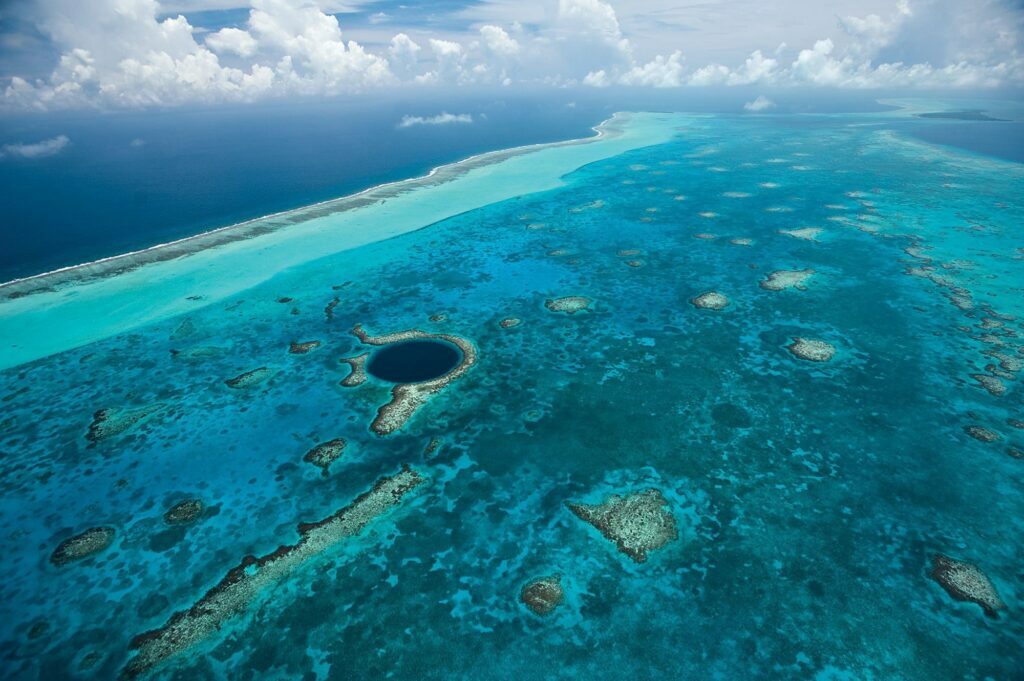
YoSo think of the Great Blue Hole as a marine cousin to inland cenotes.
🔗 [Read More About the Great Blue Hole of Belize]
🧪 The Lost Cenotes of Cara Blanca (Yalbac)
In northern Belize near Yalbac, archaeologists have mapped 13 deep freshwater cenotes known as Cara Blanca.
- Used by the ancient Maya for ritual offerings
- Found at the edge of wetlands with jade, pots, and bones inside
- Some are over 100 feet deep and perfectly circular
These cenotes are not yet open to the public — but they remind us that Belize’s sacred waters go far deeper than we think.
🔗 [Explore the Sacred Landscape of Cara Blanca]

Cenotes in Maya Culture
Cenotes are not just water sources — they’re doorways. In the ancient Maya worldview, they represented sacred portals to Xibalba, the underworld.
Here in Belize, that tradition hasn’t disappeared.
Many cenotes and caves are still treated with deep reverence. Some are avoided. Some are used in quiet ways — for drinking water, for washing, or for ceremony. Even today, some elders warn children not to linger too long near the “deep holes.” The old beliefs remain, just beneath the surface.
🔄 Cenotes, Caves, and Blue Holes — What’s the Difference?
| Feature | Cenote | Cave | Blue Hole |
|---|---|---|---|
| 💧 Water Type | Freshwater | Freshwater (or dry) | Saltwater (marine) |
| 🧱 Formation | Collapsed limestone | Erosion or tunnel systems | Reef or land collapse, flooded |
| 🏝️ Location | Inland jungle | Inland / underground | Offshore sea or deep forest |
| 🙏🏽 Cultural Use | Maya offerings, portals | Rituals, burials, protection | Rare myths, mostly diving today |
✅ Belize has all three — and sometimes they overlap.
When to Visit Belize's Cenotes
For inland cenotes like St. Herman’s Blue Hole, the dry season from March to August is ideal. You’ll enjoy clearer trails, better swimming conditions, and the jungle in full bloom. March through May offers low rainfall and better accessibility to remote areas. By June, occasional rains start to nourish the rainforest, but adventures are still possible with a good guide. Wildlife sightings also increase as the landscape transforms.
For the Great Blue Hole, calm seas are more likely from April to June, which makes this the best time for dive trips and scenic flyovers.
In ancient Maya belief, cenotes were considered portals to Xibalba—the underworld—where offerings, sacrifices, and ceremonies helped connect the living world with the spirits and gods beneath.
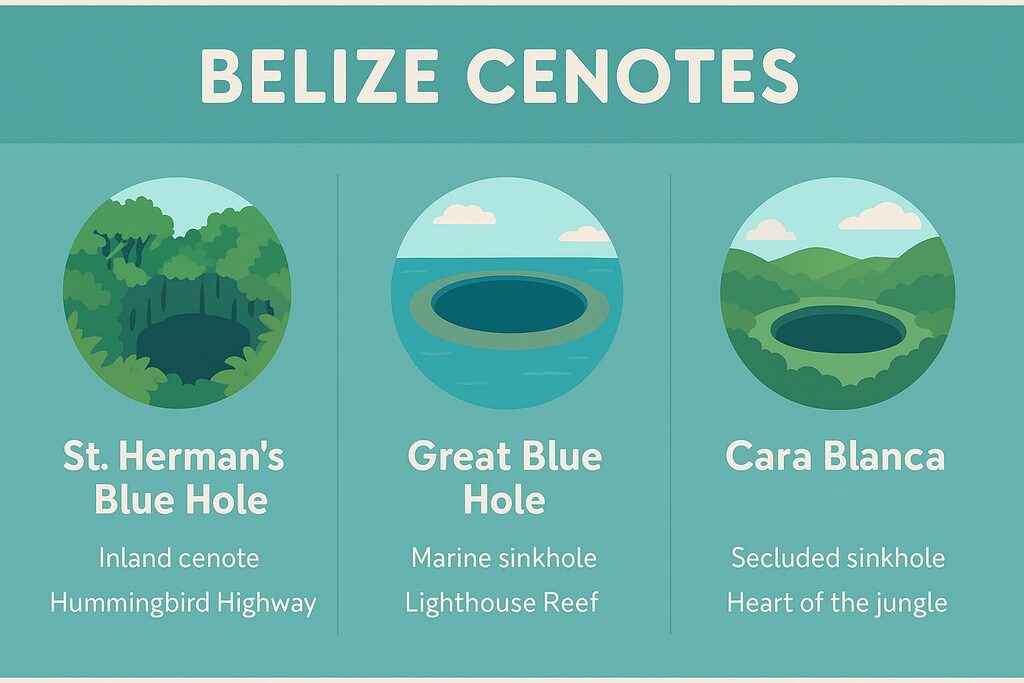
🗺️ See this on the map
Open the Interactive Map »
Frequently Asked Questions About Cenotes in Belize
A cenote is a natural sinkhole filled with water, usually formed by the collapse of limestone bedrock. Caves may or may not contain water and often extend deeper underground with chambers and passageways.
Yes, swimming is allowed at St. Herman’s Blue Hole, which is a freshwater jungle pool. However, Cara Blanca cenotes are not open to the public, and the Great Blue Hole is best suited for diving or flyovers.
It can be, but only with experienced captains. The waters beyond the reef can be dangerous. We recommend using island-based tour providers who are familiar with the conditions.
Yes. St. Herman’s Blue Hole charges BZ $2.00 for nationals and BZ $8.00 for non-nationals. The Great Blue Hole marine park has a $40 USD per person entry fee.
The dry season (March to August) is ideal, especially for inland sites. You’ll enjoy clear water, easy trail access, and lush jungle scenery. For marine cenotes like the Great Blue Hole, April to June usually offers calm seas for diving and flyovers.
The park preserves a vital section of Belize’s broadleaf jungle, cave systems, and aquifer recharge zones. It also supports biodiversity, eco-tourism, and local community income. Responsible visitation helps protect this fragile environment.
Visitors can explore the short trail and swim at the Blue Hole on their own. For cave exploration, bring a reliable flashlight, wear sturdy shoes, and notify the park office. For deeper cave sections or tubing, guided tours are recommended.
Commonly sighted sharks include Caribbean reef sharks, nurse sharks, and occasionally hammerheads. Shark sightings are not guaranteed but are a popular draw for divers.
Explorers have found massive underwater stalactites and a layer of toxic hydrogen sulfide around 300 feet deep. The bottom also holds geological clues to sea level changes during the Ice Age.
While the Great Blue Hole is generally considered safe for experienced divers, a few fatalities have occurred over the decades—mostly due to diving beyond recreational limits. Always dive with certified guides and follow safety protocols.
🧭 Let Me Guide You There
I don’t just list locations. I bring them to life.
I’ve stood at the edge of sacred pools you won’t find on maps.
If you’re ready to step off the path and into the story,
Walk with me. I’ll show you my Belize.
🔗 [See My Tours] | 🔗 [Request a Custom Trip] | 🔗 [Meet Alvin]
